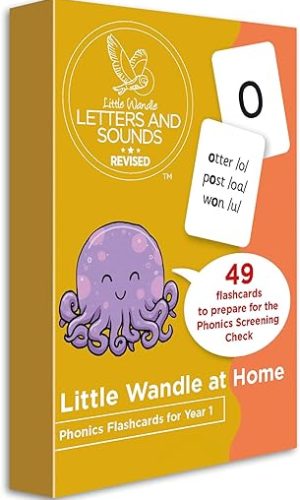Take Control of the Noisy Class: Chaos to Calm in 15 Seconds (Super-effective classroom management strategies for teachers in today’s toughest classrooms)
£15.20£22.80 (-33%)
Fed up with students who talk over you and ignore instructions?
Drained and worn out by disruption, disobedience, and defiance?
Does the thought of facing some groups fill you with utter dread?
Drawing on 20+ years experience in special education and mainstream settings, teacher-trainer Rob Plevin explains a proven, step-by-step plan for successfully managing the most challenging individuals and groups in today’s toughest classrooms. Packed with powerful, fast-acting techniques – including a novel routine to get any class quiet in 15 seconds or less – this book helps teachers across all age groups connect and succeed with hard-to-reach, reluctant learners.
You’ll discover:
- The simple six-step plan to minimise & deal with classroom behaviour problems
- How to gain trust & respect from tough, hard-to-reach students
- How to put an end to power struggles & confrontation
- How to have students follow your instructions… with no need to repeat yourself
- The crucial importance of consistency (and how to achieve it)
- Quick and easy ways to raise engagement and enjoyment in your lessons
- The ‘Clean Slate’ – a step by step method you can use to ‘start over’ with that particularly difficult group of students who won’t do anything you say.
Take Control of the Noisy Class provides hundreds of practical ideas and interventions to end your classroom management struggles & create a thoroughly enjoyable lesson climate for all concerned.
Read more
Additional information
| Publisher | Illustrated edition (25 Jan. 2019), Life Raft Media Ltd |
|---|---|
| Language | English |
| Paperback | 263 pages |
| ISBN-10 | 199934510X |
| ISBN-13 | 978-1999345105 |
| Dimensions | 17.78 x 1.52 x 25.4 cm |










by Gina
Such a brilliant insight into the reasons behind bad behaviour and practical tips on what to do. I found it really heartwarming to read that perhaps his no. 1 tip is building rapport and trust with students and understanding where they’re coming from. Sometimes as a new teacher, you feel a pressure to be one of the loud shouty ones strutting around seeming very impressive. But that kind of aggro is really not my bag, plus, I’d rather not end up with nodules on my vocal chords. Far better that my kids were behaving because they respected me and trusted that I had their best interests at heart rather than doing so under duress.
by Marcus Woodhouse
This is a gift for my eldest daughter who I didn’t manage to put off of a career in teaching.
by A Listener
There’s some good stuff in this book – I like the chapter on building relationships – but buyers should be aware that it seems to be aimed at properly ‘out of control’ classes (or perhaps at secondary classes, I’m not sure). I’ve taught in challenging primary mainstream settings and lots of the tips here would not be necessary in those schools. It’s not about just making classes more focused – it’s about classes who really don’t want to learn (which I’ve not really seen at primary level). I’m sure it will be very useful for some contexts though, and is very well written.
by Listen Girl 58
Can’t rate this highly enough; lots of hints, tips and tricks for classroom management. If you have a young teacher in your circle this would make a great gift. Very apt, humorous and skilful illustrations, too. Five stars!
by Sgintares
Very usefull
by beckybose
What I love most about this book are the practical examples that allow you to immediately apply Rob Plevin’s philosophy of teaching, his dedication to positive reinforcement and behaviour management, which is rooted in mutual respect and fun, in the classroom with confidence. He even tells you exactly what to say. A complete dream for a newbie teacher. How often are we faced with experienced mentors firing back a “well what would you do?” when you ask them direct questions about issues with behaviour management – “I really don’t know” is usually my answer! “That’s why I’m asking you. I’m at the end of my tether!”.
In every chapter (and in a helpful reference list at the back) are a set of ways that you can apply his ideas straight away but more importantly – and like all good teachers – he relates the ideas back to our own experiences as teachers and human beings. In the chapter Positive Reinforcement, Rob tells the brutally honest story of his own financial rock bottom – it was only then did he realise that punitive action has little to no effect on those who already feel lowest of the low. Unsurprisingly, it was praise and a significant elevation in self-esteem that came flooding in from his devoted supporters that got him back on his feet. And it’s that story that sticks with me now as I deliver meaningful praise, – which for me is sometimes entirely scripted by Rob’s examples. I know that I will become more spontaneous in time, but in the meanwhile I find the actual tools for dealing with the toughest part of this job are contained almost wholesale within the pages of this book. Thank you Rob – from me and from the numerous troubled souls that have also benefitted from me applying your years of wisdom and kindness of heart in my own classroom.
by Mr Kevin Hewitson
Perhaps it’s the title that draws you into this book by Rob Plevin, perhaps it’s because you are a teacher and want to improve your pedagogy or perhaps you picked it up because you had little else to do at the time. Whatever the reason – read it, it’s about much more than just controlling a noisy class!
My father used to say there is nothing common about common sense. My time in teaching suggests this is true and that when you do find it you find it by the thimble full and not by the bucket. In his book Rob has managed to fill several buckets full of this rare commodity. As a result the book is full of strategies that you find yourself saying, “That’s so simple but effective, its common sense”, time after time.
“Strategy” is a key word for what Rob presents, they are well thought out and cover all the key issues of managing teaching and creating an engaging learning environment. Don’t be put off by some of the extreme examples Rob includes, this is both a reflection of the effectiveness of the strategies and his experience in refining them “at the sharp end” so you know they work. There is much here that a “seasoned” teacher knows and Rob does an excellent job of sharing this in a practical way. Just remember to ask “What colour are your socks?” next time you face a conflict situation.
Other key words and actions that run throughout the book include “empathy”, “consistency”, “being clear”, “consequences” and “humour”. It is not until part way through the book that Rob’s humour begins to show but it is essential to recognise it if you are going to get the most from the strategies he suggests. Simply copying what Rob suggests to your own teaching without considering this most effective element will mean you fail to gain the most from his words. You will be a marionette carrying out somebody else’s action and they will not be genuine to you. Be warned students will work this out and they do not trust a simulacrum.
If this book does not do anything else it should make you reflect on your own teaching. It should encourage you to see the why behind the success of the strategies you already use and how to improve those that do not always work. Some sage advice from Rob “Whatever you allow to happen in class, you effectively encourage”
Finally Rob acknowledges the importance of home relationships throughout the book. I know this can appear time consuming, the letter home, the phone call, the meeting but as Rob points out it is essential if you are going to take control. The partnership of home, school, and student is the most effective one for showing you care and even the most pressured teacher should include it in their strategies.